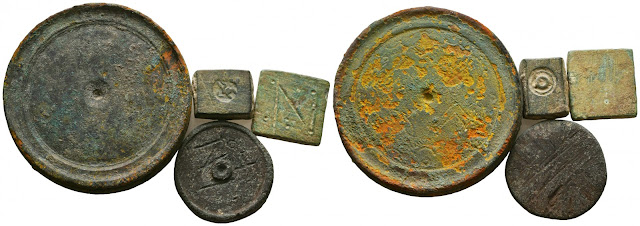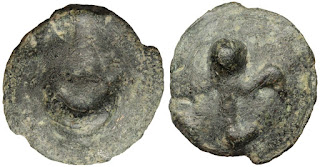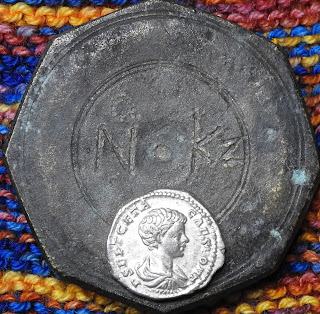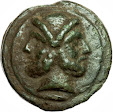rrd top 10 2021
1.
Aes
Grave Dupondius 230-220 BC, Semi-Libral standard. Volaterrae (Etruria) mint.
Obv - Janiform head of Culsans, wearing pointed petasus; Rev - Club; I I (mark
of value) across field; around Etruscan retrograde legend - FEΛA-OΔI (velaθri);
266 grams, 73 mm
2.
II
VNCIA, ૪ B bronze barrell weight
- commercial scale weight, late Roman or early Byzantine, Sextans or two VNCIA;
on the top, the value is shown in Greek script, ૪ B. The Latin II VNCIA is extremely
unusual and shown on the side; 24.6 mm max dia X 20.5 mm min dia X 14.5 mm tall;
53.23 grams (319.4 eq As)

3.
Cast
AE Nummus (As), Apulia, Luceria, 225-217 BC; Obv - Head Apollo left, hair tied
with ribbon; below chin – mark of value: I; Rv. Rooster standing left. Most
books list 3 variations on this coin. Two types have letters around the
rooster: L.SEXTI.SEP.BABI or M.LAVINIO. A third type, this coin, has no
letters; 214.5 grams, 66 X 14.6 mm
4.
27
Nomismata (4.5 uncia) Byzantine bronze coin weight, octagonal, disc-shaped; Obv:
N° KZ, decorated with two double circular lines, above the N is a small zero. Nomistmata
weights place the zero above or to the right of N. 116.9 grams, 49.3 X 7.3 mm.
The denomination is rare. There are no examples in Pondera. The weight is
similar to a 17 N weight purchased in the same lot. The weight is shown with a denarius of Geta for comparison.
27 N (N° KZ) and 17 N (N° IZ)
5. Roman
Republic, Aes Grave, Apollo/Apollo Series, Cast Triens, Rome, 270 BC; Obverse -
Head of horse r.; below, °°°°; Reverse - Same type l. 114 grams, 50 mm, 12 H,
Crawford 18/3. I wish the 4 dots were more prominent. Otherwise the coin is
excellent.
6.
Olbia
AE 68 Gorgoneion Eagle - The coin below covers 3 and a half of the fingers on
my hand. It is big. CNG notes the patina was removed. That is not obvious at
first glance, but is glaring when I take pics. I think Medusa sticking out her
tongue is neat. The coin was sold twice by CNG.
7.
Roman
/ Byzantine Four Ounce Commercial Scale Weight; 100 - 500 AD Obverse – 4 dots; the rest of the surface is
hard to see. If the scale weight is 4 uncia it would have Гo Δ. Reverse
– Cross? +? The mark on the weight, +, is similar to the mark on a Semis of C.
Curiatius f. Trigeminus, see below. Dating depends on how you read the reverse.
105.7 grams.
a.
I
found this weight at H Berk online while searching for other 4 ounce scale
weights. I had to have it.... so it is #7.a. Byzantine Round Commercial Bronze
Weight; 4-Ounces (Triens) or 24-Nomismata / Solidii; 6th-7th cent. AD. I wish
there was a way to convert Bф into 4 or 24.
8. Double
Struck Ptolemaic Kings of Egypt, AE Oktobol, Hockey Puck; Ptolemy III
Euergetes; Obv: Laureate head of Zeus Ammon right, border dots. Rev: Eagle with
open wings standing left on thunderbolt, looking right; E between legs.
ΠTOΛEMAI[OY] BAΣIΛ[EΩΣ]; 80.8 grams; 46 mm dia X 7.5 mm thick
9.
Roman Republican struck Uncia, Obv: Radiate and draped bust
of Sol facing slightly right; pellet (mark of value) to left. Rev: Pellet (mark
of value) and two stars within crescent, in ex ROMA; Crawford 39/4; 12.75
grams, 23 mm
10.
APULIA,
LUCERIA, AE Aes Grave semuncia, 268-250 BC; Obv: Crescent, Rev: Thyrse adorned
with a garland.19.20 grams. I like this coin because it has an equivalent
Nummis (or As in 10 ounce system of Luceria) of 384 grams which is well above one
Roman pound. Heavy indicates an early series.
1. Dupondius Etruria Volterrae
2. Two VNCIA barrel weight
3. Nummus Apollo Rooster
4. 27 Num/Sol coin wt, 17, 12, 10
5. Triens Horse Head / horse head
6. Olbia AE 68 Gorgoneion Eagle
7. Four Uncia commercial weights (two pieces)
8. PTOLEMAIC KINGS OF EGYPT. Octobol
9. Uncia Sol / moon and stars
10. Luceria Cast Semuncia heavy series Crescent Thyrsus 400g equiv As
Next few:
11. Teruncius Stingray Dolphin
12. Sextans wolf & twins
13. one As commercial weight & half As commercial weight - the top two were bought as a lot from Gorny & Mosch. Shown below are weights from previous years.









.jpg)























































